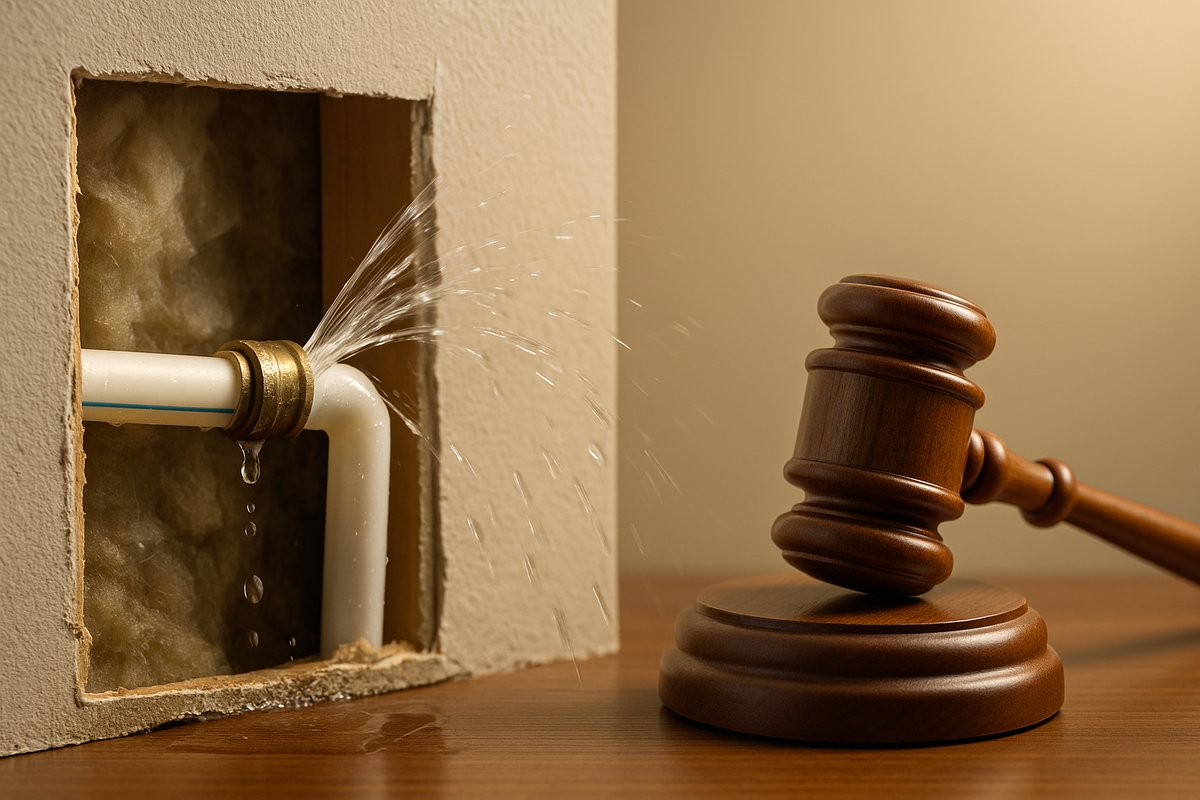Homeowners keep asking about the Uponor PEX Lawsuit. Leaks turn into repairs. Repairs turn into bills. Confusion follows. You deserve straight answers now. This guide explains claims, timelines, and remedies in plain words. It also shows how to act fast and protect your home. Recent filings and investigations make the picture clearer today.
The Uponor PEX Lawsuit does not mean one case. It covers several actions across states. Some target colored AquaPEX tubing. Others investigate newer product runs. A few discuss fittings or system-level failures. Several firms are now evaluating class claims. Courts already hold earlier complaints on record. You need the facts behind those headlines.
Expect a direct, practical walkthrough. You will see the exact problem theories, what evidence matters and who may qualify. You will also see clear steps for claims. The goal is simple. Turn stress into a plan you can follow today.
What the “Uponor PEX Lawsuit” Covers
The phrase Uponor PEX Lawsuit spans four themes. Each theme affects strategy and proof. Keep these buckets in mind as you read.
- Colored PEX tubing oxidation and cracking.
Plaintiffs say red, white, and blue pipes degrade too quickly. Failures appear in three to ten years. Microcracks and embrittlement lead to leaks. Investigations blame heat treatment and lost antioxidants. - Manufacturing-era focus after 2010 and 2020.
Law firms are probing pipes made and installed in recent years. Several notices mention installations after 2010. Newer posts discuss systems installed after 2020 as well. - Class action posture and new case filings.
New complaints describe system-wide risks and property damage. A Tennessee filing details alleged design and manufacturing defects. It targets colored PEX in particular. - Parallel investigations and intake portals.
Multiple firms now solicit claimant details. Their pages explain oxidation, embrittlement, and failure modes. They also preview refund and replumb remedies.
These buckets overlap in many homes. Your timeline, pipe color, and install date will guide your next move.
The Core Allegation: Oxidation, Microcracks, and Early Leaks
Plaintiffs say certain colored AquaPEX pipes degrade early. The theory centers on oxidation and additive loss. Reports point to flame or furnace surface treatment that helps color coatings adhere. That heat exposure can consume stabilizers that protect against oxidation. The pipe then embrittles and forms exterior microcracks. Leaks follow years later under normal use.
Recent articles and firm investigations mirror that description. They cite failures within three to ten years. That is far below the marketed lifespan for PEX. Owners report pinhole leaks, cracking, and water damage in walls and slabs. Builders then face warranty fights and reputation hits.
Not every colored pipe will fail. Risk depends on manufacturing run, handling, water chemistry, and temperature. Allegations still claim a systemic vulnerability. The claim says the surface treatment sets the stage. Time and pressure then reveal the weakness.
What Products and Years Are Under Scrutiny
Complaints and investigations focus on red, white, and blue AquaPEX. Early coverage flagged red and blue runs. Newer pieces also include white lines. Firms highlight installs after 2010. Some outreach pages now mention installations after 2020 as well. Exact SKUs and plant runs will matter in discovery. Keep packaging photos and invoices if you have them.
Courts and experts examine batch data and process history. They compare failure rates across colors and years. Also, they assess stabilizer levels and heat exposure. They also weigh local water conditions and chlorine exposure. These details drive causation and damages later.
Known Filings and the Litigation Posture
A Tennessee complaint filed in 2023 lays out a broad class theory. It targets alleged design and manufacturing defects in colored PEX. The filing seeks damages for replacement costs and property losses. It also seeks class relief across affected owners. That case tracks earlier reporting and technical theories. More filings followed in other states.
ClassAction-focused outlets documented a Colorado case in 2021. That post highlighted oxidation and microcracks tied to color coatings. It also described the alleged heat-treatment mechanism. Updates continued into 2024 as claims expanded. New coverage in 2025 again spotlights the same failure mode.
Parallel firm pages in 2025 show active intake. They emphasize premature degradation. They mention potential class action paths. These pages reinforce that national counsel are coordinating claims now.
Symptoms You May See at Home
Physical signs often appear before a major leak. Document small clues early.
- Pinhole leaks behind drywall.
Water stains or bubbling paint point to tiny ruptures. Damp spots near joints often show first. - Cracking or chalky pipe surfaces.
Exterior microcracks may look like tiny craze lines. A chalk-like surface can signal oxidation. - Intermittent drops in pressure.
Pressure dips may follow slow leaks into walls. Meter changes can confirm that loss. - Recurring musty odors or mold growth.
Hidden leaks feed mold in studs and insulation. Air tests or infrared scans may reveal moisture. - Multiple leaks in different rooms.
Systemic failure often spreads across branches. That pattern suggests material issues, not installer error.
Take clear photos. Date-stamp every image. Save damaged pipe sections in sealed bags if safe.
How Experts Evaluate the Cause
Engineers test sections for oxidation markers and additive depletion. They examine fracture surfaces under magnification, compare wall thickness, crystallinity, and ductility. They also check for chlorine attack and stress cracking. Batch data and plant logs help link failures to process variables. Those findings then support or rebut the class theory.
Attorneys often run a triage kit. They match your pipe coloration, print lines, and installation date. Also, they ask about water chemistry and temperatures. They evaluate the leak pattern across branches and floors. That triage informs your next legal step.
Repair Choices: Spot Fixes vs. Replumb
Owners usually face two paths. Spot repairs solve immediate leaks. Replumb projects reduce future risk across the system.
Spot repairs cost less up front. They leave the rest of the system in place and make sense after isolated damage. They may fail if material aging is widespread.
Replumb projects replace main runs and branches. They can include different PEX or copper lines. They cost more now and save rework later. Insurers sometimes fund parts after major losses. Counsel can push for broader relief in class or individual claims. Keep invoices and contractor notes either way. Courts need those numbers to value damages.
What Compensation Could Cover
Typical requests include pipe replacement, drywall work, paint, flooring, cabinetry, and temporary housing. Owners can also seek mold remediation and testing. Attorneys may add diminished value where damage was severe. Class structures sometimes include inspection and replacement programs. Current investigations discuss refunds and replumbs as potential outcomes. Final relief will depend on court approvals or settlements.
How To Preserve Your Claim
Move fast and build a clean file. Small steps today unlock options later.
- Photograph every leak site from multiple angles.
- Save failed pipe sections in labeled bags if safe to handle.
- Collect packaging photos and purchase records if available.
- Request a plumber’s report that mentions pipe color and markings.
- Order a water bill history that shows unusual usage spikes.
- File an insurance claim and keep all adjuster notes.
- Start a timeline of leaks, repairs, and costs.
- Consult counsel for class fit and deadlines.
These steps raise settlement leverage. They also speed reimbursements from insurers.
Warranty, Insurance, and Litigation Paths
Check your product warranty language. Coverage often excludes consequential damage. Insurers then fill the gap for walls and floors. Counsel can coordinate both channels. Class action participation may sit alongside individual repair claims. A court may later set deadlines and proof rules. Firms now screen owners nationwide for eligibility.
If your home sits in a jurisdiction with active filings, coordination helps. Counsel may advise holding sections of pipe for joint testing. They may also suggest targeted inspections across risk branches. Strategy will match your timeline, leak history, and budget.
What to Expect Next in 2025
Coverage expanded again in 2025. New articles repeat the oxidation theory and short failure window. More firms opened investigations this summer. Activity suggests broader class coordination in the near term. Owners should prepare documentation now. Early files earn faster attention when programs launch.
Quick Decision Guide
- One leak only?
Consider a spot repair and close monitoring. Document everything. - Two or more leaks?
Consider a replumb estimate and legal intake. Patterns point to material risk. - New stains or odors?
Order a moisture scan and open minimal walls. Find the source early. - Unsure about eligibility?
Send pipe photos and install dates to counsel. Ask about class timing.
Sample Documents You Can Use
Contractor note
“Please describe the pipe color, print line, and any visible microcracks in your report.”
Insurance email
“I reported leaks on [dates]. Please confirm coverage for drywall, flooring, and remediation.”
Counsel intake
“My home has red/blue/white AquaPEX installed in [year]. I have photos, invoices, and two repair bills.”
These simple lines build a precise paper trail.
Frequently Asked Questions
Is the Uponor PEX Lawsuit one nationwide case?
No. It includes several cases and firm investigations across states. Each matter targets similar oxidation and cracking theories.
Which pipes are most discussed?
Red, white, and blue AquaPEX appear most in recent posts and filings. Color and year matter to eligibility.
How soon can pipes fail?
Some reports cite failures in three to ten years. That is far shorter than expected lifespans.
Does installer error explain the leaks?
Sometimes. Yet multiple leaks across branches support a material theory. Experts then test for oxidation and additive loss.
Can I claim costs for walls, floors, and mold?
Often yes through insurers and defendants. Keep invoices and testing reports to support those amounts.
What if my pipes were installed after 2020?
Some intake pages now flag post-2020 installs for review. Provide your dates and photos during screening.
Do I need to save the failed pipe?
Yes, when safe. Label and store it dry. That evidence can support lab testing later.
Will a class settlement provide a replumb?
Too early to say. Prior plumbing settlements in other brands included replumb options. Firms now discuss similar relief here. Outcomes depend on court approvals.
Conclusion
The Uponor PEX Lawsuit now focuses on colored AquaPEX oxidation and early cracking. New filings echo older reports. Firms launched fresh investigations this year. Evidence points to surface treatment, antioxidant loss, and embrittlement. Failures then appear within a decade in many homes. Replacement costs and repairs stack up fast.
Your best move is simple. Photograph leaks and failed sections. Gather invoices and install dates. Order a contractor report that mentions color and markings. Push insurers to fund walls, floors, and remediation. Send a clean file to counsel for screening. That tight record speeds relief and strengthens your leverage. The Uponor PEX Lawsuit will keep evolving in 2025. More data will refine risk windows and product sets. Your documentation will decide outcomes for your home. Stay organized. Act early. Protect your property value today.




